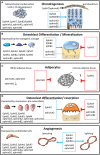Eph-Ephrin Signaling Mediates Cross-Talk Within the Bone Microenvironment
- PMID: 33634116
- PMCID: PMC7902060
- DOI: 10.3389/fcell.2021.598612
Eph-Ephrin Signaling Mediates Cross-Talk Within the Bone Microenvironment
Abstract
Skeletal integrity is maintained through the tightly regulated bone remodeling process that occurs continuously throughout postnatal life to replace old bone and to repair skeletal damage. This is maintained primarily through complex interactions between bone resorbing osteoclasts and bone forming osteoblasts. Other elements within the bone microenvironment, including stromal, osteogenic, hematopoietic, endothelial and neural cells, also contribute to maintaining skeletal integrity. Disruption of the dynamic interactions between these diverse cellular systems can lead to poor bone health and an increased susceptibility to skeletal diseases including osteopenia, osteoporosis, osteoarthritis, osteomalacia, and major fractures. Recent reports have implicated a direct role for the Eph tyrosine kinase receptors and their ephrin ligands during bone development, homeostasis and skeletal repair. These membrane-bound molecules mediate contact-dependent signaling through both the Eph receptors, termed forward signaling, and through the ephrin ligands, referred to as reverse signaling. This review will focus on Eph/ ephrin cross-talk as mediators of hematopoietic and stromal cell communication, and how these interactions contribute to blood/ bone marrow function and skeletal integrity during normal steady state or pathological conditions.
Keywords: Eph-ephrin communication; bone marrow mesenchymal stem cells; bone marrow microenvironment; hematopoietic stem cells; musculoskeletal pathology; osteogenic differentiation; osteoimmunology; vasculature.
Copyright © 2021 Arthur and Gronthos.
Conflict of interest statement
The authors declare that the research was conducted in the absence of any commercial or financial relationships that could be construed as a potential conflict of interest.
Figures




Similar articles
-
The role of Eph/ephrin molecules in stromal–hematopoietic interactions.Int J Hematol. 2016 Feb;103(2):145-54. doi: 10.1007/s12185-015-1886-x. Int J Hematol. 2016. PMID: 26475284 Review.
-
[Regulation of bone metabolism by Eph-ephrin family members].Clin Calcium. 2012 Nov;22(11):1669-75. Clin Calcium. 2012. PMID: 23103810 Review. Japanese.
-
Crosstalk between skeletal and neural tissues is critical for skeletal health.Bone. 2021 Jan;142:115645. doi: 10.1016/j.bone.2020.115645. Epub 2020 Sep 16. Bone. 2021. PMID: 32949783 Review.
-
EphB/ephrin-B interactions mediate human MSC attachment, migration and osteochondral differentiation.Bone. 2011 Mar 1;48(3):533-42. doi: 10.1016/j.bone.2010.10.180. Epub 2010 Nov 5. Bone. 2011. PMID: 21056708
-
Eph and ephrin interactions in bone.Adv Exp Med Biol. 2010;658:95-103. doi: 10.1007/978-1-4419-1050-9_10. Adv Exp Med Biol. 2010. PMID: 19950019
Cited by
-
Cancer-Related Mutations in the Sam Domains of EphA2 Receptor and Ship2 Lipid Phosphatase: A Computational Study.Molecules. 2024 Feb 27;29(5):1024. doi: 10.3390/molecules29051024. Molecules. 2024. PMID: 38474536 Free PMC article.
-
Inbreeding depression and the probability of racing in the Thoroughbred horse.Proc Biol Sci. 2022 Jun 29;289(1977):20220487. doi: 10.1098/rspb.2022.0487. Epub 2022 Jun 29. Proc Biol Sci. 2022. PMID: 35765835 Free PMC article.
-
ED-71 Improves Bone Mass in Ovariectomized Rats by Inhibiting Osteoclastogenesis Through EphrinB2-EphB4-RANKL/OPG Axis.Drug Des Devel Ther. 2024 May 6;18:1515-1528. doi: 10.2147/DDDT.S454116. eCollection 2024. Drug Des Devel Ther. 2024. PMID: 38716369 Free PMC article.
-
A Multifunctional Therapeutic Strategy Using P7C3 as A Countermeasure Against Bone Loss and Fragility in An Ovariectomized Rat Model of Postmenopausal Osteoporosis.Adv Sci (Weinh). 2024 Jun;11(21):e2308698. doi: 10.1002/advs.202308698. Epub 2024 Mar 13. Adv Sci (Weinh). 2024. PMID: 38477537 Free PMC article.
-
EPHA2 Receptor as a Possible Therapeutic Target in Viral Infections.Curr Med Chem. 2024;31(35):5670-5701. doi: 10.2174/0109298673256638231003111234. Curr Med Chem. 2024. PMID: 37828671 Review.
References
-
- Adams R. H., Wilkinson G. A., Weiss C., Diella F., Gale N. W., Deutsch U., et al. . (1999). Roles of ephrinB ligands and EphB receptors in cardiovascular development: demarcation of arterial/venous domains, vascular morphogenesis, and sprouting angiogenesis. Genes Dev. 13, 295–306. 10.1101/gad.13.3.295 - DOI - PMC - PubMed
Publication types
LinkOut - more resources
Full Text Sources
Other Literature Sources
Miscellaneous

